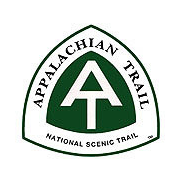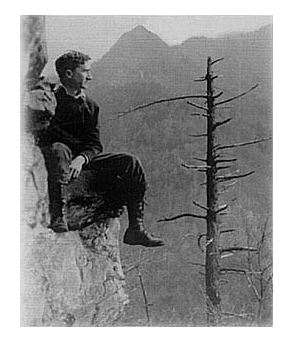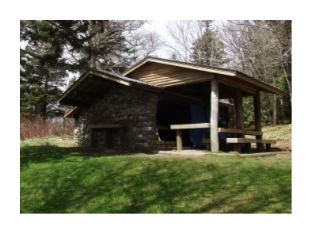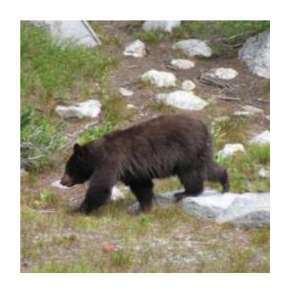Appalachian Trail Guide for Great Smoky Mountains National Park
The Appalachian Trail, also known as the A.T., runs for more than 71 miles through Great Smoky Mountains National Park. It enters the park from the south at Fontana Dam, and exits in the northeast at Davenport Gap. The highest point anywhere along the 2180-mile trail is 6625 feet, at Clingmans Dome. The trail also passes by other notable landmarks in the Smoky Mountains, such as Charlies Bunion, Rocky Top and the historic stone fire tower atop Mt. Cammerer.
 It usually takes 7 days for most people to hike the Smoky Mountains section of the Appalachian Trail. If you don't have that much time, this hike can easily be shortened by using Newfound Gap or Clingmans Dome as a mid point. Either of these sections of the A.T. can be done in 3 or 4 days. Of course, since these are all one-way trips, you'll have to arrange for some sort of transportation at the end of your hike.
It usually takes 7 days for most people to hike the Smoky Mountains section of the Appalachian Trail. If you don't have that much time, this hike can easily be shortened by using Newfound Gap or Clingmans Dome as a mid point. Either of these sections of the A.T. can be done in 3 or 4 days. Of course, since these are all one-way trips, you'll have to arrange for some sort of transportation at the end of your hike.
Hikers follow along the Appalachian Trail with the help of a system of "blazes" painted on trees, posts, and rocks. Although there are some local variations, most hikers grasp the system fairly quickly. Above tree-line, or in places where snow or fog can obscure paint marks, wooden posts and rock piles, known as "cairns," are used to identify the route.
White-paint blazes two inches wide and six inches high are used to mark the Appalachian Trail. Side trails and pathways that lead to shelters use blue blazes. Two white blazes, one above the other, indicate an obscure turn, route change, incoming side trail, or some other situation that requires hikers to be alert to an upcoming change in direction. In some states, one of the two blazes will be offset in the direction of the turn.
Brief History
The Appalachian Trail was the brainchild of Benton MacKaye, a Massachusetts regional planner and forester for the United States Forest Service, as well as a cofounder of The Wilderness Society. His idea for a continuous wilderness trail was proposed in an article published in the Journal of the American Institute of Architects in 1921, entitled, "An Appalachian Trail: A Project in Regional Planning." His vision for this long-distance trail was to provide leisure, enjoyment, and the study of nature for people living in the urban areas of the eastern United States.
Just two years later, on October 7, 1923, the first section of the Appalachian Trail, from Bear Mountain-Harriman State Park to Delaware Water Gap, was completed. MacKaye then called for a two-day Appalachian Trail conference to be held in Washington D.C. in 1925. This resulted in the formation of the Appalachian Trail Conference (now the Appalachian Trail Conservancy). Little progress, however, was made on the trail over the next several years.
 The trail wasn't completed until August of 1937 when the Civilian Conservation Corps connected the ridge between Spaulding and Sugarloaf Mountains in Maine. The 1968 National Trails System Act designated the A.T. as a linear national park, and authorized funds to surround the entire route with public lands, either federal or state, while protecting it from incompatible uses. Now roughly 2180 miles in length, the Appalachian Trail passes through 14 states and 6 national parks.
The trail wasn't completed until August of 1937 when the Civilian Conservation Corps connected the ridge between Spaulding and Sugarloaf Mountains in Maine. The 1968 National Trails System Act designated the A.T. as a linear national park, and authorized funds to surround the entire route with public lands, either federal or state, while protecting it from incompatible uses. Now roughly 2180 miles in length, the Appalachian Trail passes through 14 states and 6 national parks.
Although the Appalachian Trail was the brainchild of Benton MacKaye, it was Harvey Broome and Paul Fink that made it a reality in the Great Smoky Mountains.
Harvey Broome was an early environmentalist, another one of the cofounders of The Wilderness Society, and a one-time president of the Smoky Mountains Hiking Club. In 1932 he and seven others hiked the 71+ miles of Appalachian Trail through the Smokies before the trail was even completed. He was also largely responsible for sighting most of the route thru the national park.
Paul Fink, another leader of the movement that led to the founding of the Smoky Mountains as a national park, was also instrumental in blazing the A.T. through the Smokies. Fink was a member of the Board of Managers of the Appalachian Trail from 1925 to 1949, and was the author of "Backpacking Was the Only Way", an account of early 20th century camping and backpacking adventures in the southern Appalachians.
Backcountry Shelters
While in the Smoky Mountains, hikers are required to camp only in designated campsites or in shelters. There are 12 shelters located along the 71.6-mile stretch of the Appalachian Trail in the Smokies. All of them have been refurbished in recent years, and several now have moldering privies, which use an active biological soil layer to break down waste.
 Additionally, when the shelters were refurbished, the chain-link fences that were used to keep bears out have been removed. It's now extremely important to cook and eat away from the shelters in order to keep the bears away.
Additionally, when the shelters were refurbished, the chain-link fences that were used to keep bears out have been removed. It's now extremely important to cook and eat away from the shelters in order to keep the bears away.
Backcountry shelters are the best places to overnight during bad weather, and tend to fill up fast when it rains. Shelters also eliminate the need for tents. They're often a good place to meet and talk with other hikers, and most have privies and water sources nearby. Most importantly, however, staying in shelters reduces the impact to the surrounding environment, which is one of the key "Leave No Trace" practices. It concentrates use in a relatively small area, thereby leaving nearby areas in a more pristine state. Reservations are required for all shelters in the Smoky Mountains and can be made by calling (865) 436-1231. If you're caught without a permit you could be fined up to $5000 per violation and/or spend 6 months in jail!
Drinking Water
The Park Service recommends that all drinking water should be treated as a result of the presence of Giardia lamblia in park waters. If the parasite is ingested you could end up with an intestinal disorder that doesn't appear until after your trip. The easiest method of effective water treatment is to boil water for one minute, or use a filter capable of removing particles as small as 1 micron.
Bears
 Based on the most recent study conducted in 2006, park biologists estimate that roughly 1500 black bears live within the Great Smoky Mountains, a density of approximately two bears per square mile. These bears are wild and their behavior is sometimes unpredictable. Although extremely rare, attacks on humans have occurred, inflicting serious injuries and death. Treat bear encounters with extreme caution.
Based on the most recent study conducted in 2006, park biologists estimate that roughly 1500 black bears live within the Great Smoky Mountains, a density of approximately two bears per square mile. These bears are wild and their behavior is sometimes unpredictable. Although extremely rare, attacks on humans have occurred, inflicting serious injuries and death. Treat bear encounters with extreme caution.
To avoid encounters while camping or backpacking it's extremely important to know how to store food and trash. When not being consumed or transported, all food and trash must be suspended at least 10 feet off the ground, and four feet from the nearest limb or trunk. Not only does this protect you and future hikers, it also protects the bears. To get a better understanding of bear behavior and what to do if you see one on the trail, click here.
Additional Resources:
National Geographic Trails Illustrated Map for the Smoky Mountains
Nat Geo Sectional Maps: Western Smokies / Eastern Smokies
Nat Geo Topographic Map Guide for the Appalachian Trail in the Smokies
Backcountry Rules and Regulations for the Smokies
Campsite and Shelter information (GPS waypoints, maps, etc.)
Temporary road, campsite and shelter closures, and water issues
Appalachian Trail Forum: info, articles, tips, advice and pictures
Appalachian Trail Shuttle Services
Appalachian Trail Guide to Tennessee-North Carolina